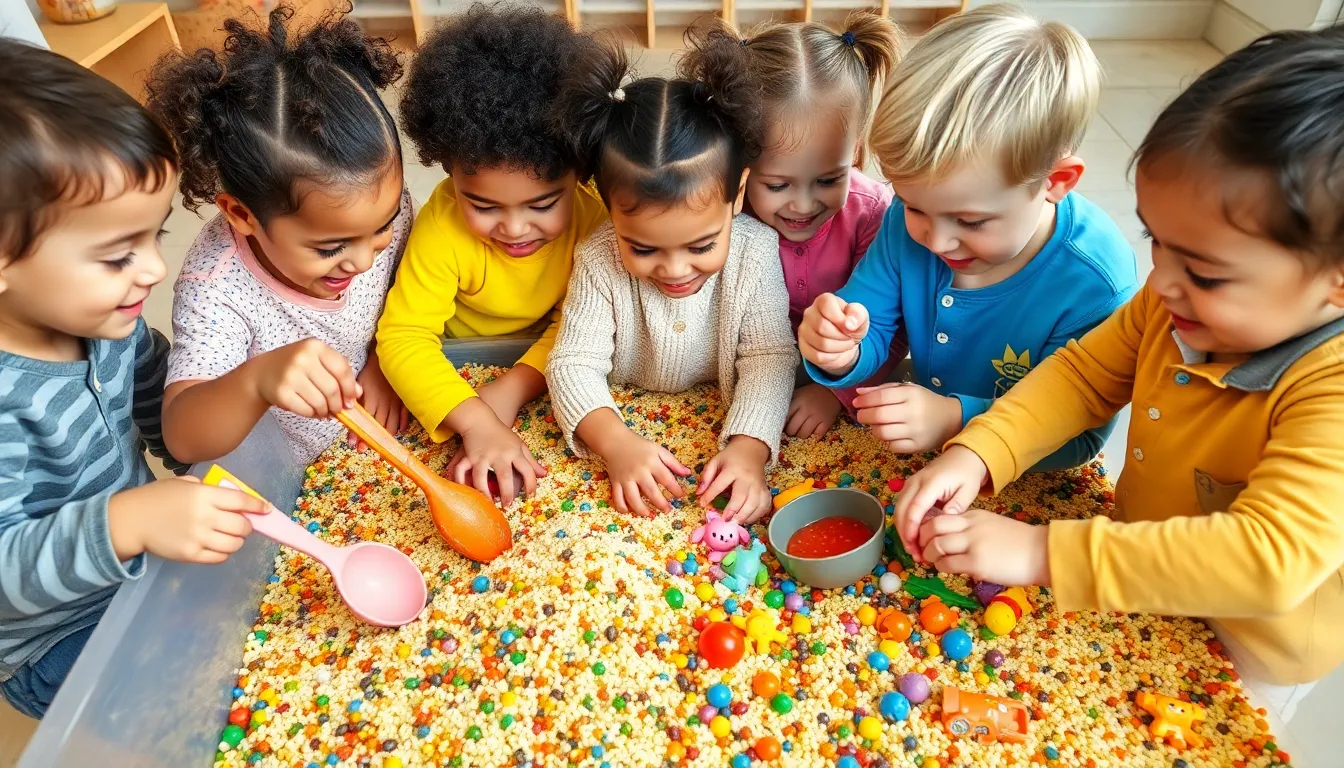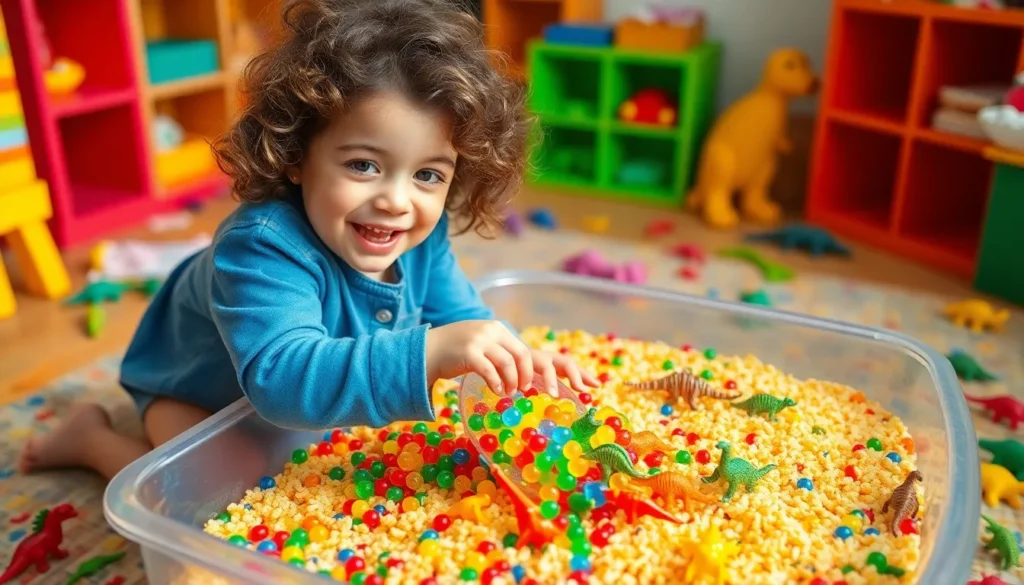Table of Contents
ToggleImagine a world where mess equals magic and creativity knows no bounds. Enter the realm of sensory bins—those delightful containers filled with treasures that spark joy and curiosity in children. These activities aren’t just about filling a box with rice and toys; they’re gateways to exploration, learning, and a bit of chaos that every parent secretly loves.
What Are Sensory Bins Activities?
Sensory bin activities involve containers filled with a variety of materials that stimulate a child’s senses. These bins often include beans, rice, sand, water beads, or other tactile items. Children engage with these materials through scooping, pouring, and exploring, enhancing their fine motor skills.
The educational value of sensory bins extends beyond simple play. They promote cognitive development by encouraging problem-solving and creativity. For instance, adding themed elements, such as dinosaurs or ocean life, introduces opportunities for imaginative play while teaching children about different subjects.
Multisensory experiences emerge as children manipulate various textures, weights, and shapes. Exploring these differences helps children develop sensory processing skills. This exploration often leads to enhanced vocabulary as they describe their experiences.
Parents and educators widely appreciate sensory bins for their versatility. Creating different themes allows for seasonal activities, holiday exploration, or even specific educational goals. Changing materials regularly prevents boredom and keeps children engaged with fresh experiences.
Ultimately, sensory bins foster an environment rich in exploration and learning. They support essential developmental milestones while offering a fun and engaging way for children to learn through play.
Benefits of Sensory Bins Activities

Sensory bins offer numerous advantages for children’s development. These activities support various crucial growth areas.
Enhancing Cognitive Development
Children engage in critical thinking through sensory bin play. Manipulating different materials encourages problem-solving and decision-making skills. Themed elements spark imagination while introducing concepts such as colors or counting. When children explore textures and weights, they connect ideas and enhance their understanding of the world. Vocabulary growth occurs naturally as kids describe their sensory experiences and interactions. These enriching activities cultivate creativity, enabling children to express their thoughts freely.
Promoting Fine Motor Skills
Fine motor skills receive significant attention during sensory bin activities. Children scooping, pouring, and sorting materials practice hand-eye coordination. Various tools like tongs or scoops enhance dexterity as kids manipulate objects of different sizes and shapes. These tasks strengthen hand muscles, preparing them for writing and other tasks requiring precision. The variety of textures and forms keeps children engaged and eager to explore more. Skills acquired during sensory play translate into daily activities, fostering independence and confidence in their abilities.
Types of Sensory Bins Activities
Various sensory bin activities cater to children’s developmental needs and interests. Each type provides unique learning opportunities.
Seasonal Themed Bins
Seasonal themed bins celebrate changes throughout the year. For example, autumn bins can include leaves, pinecones, and small gourds. These materials allow children to explore textures while learning about seasonal changes. Winter bins could feature fake snow, small figurines, and holiday decorations. Activities engage kids in discussions about winter weather or holiday traditions. Spring-themed bins often showcase flowers and colorful soil. Children not only appreciate the tactile experiences but also connect with nature’s cycles.
Educational Bins
Educational bins integrate academic concepts in playful ways. Counting beads or letters in a rice bin encourages children to practice numeracy and literacy skills. Science-themed bins can introduce plants, insects or minerals, sparking curiosity and discussion. Medical play bins might include toy stethoscopes and bandages, fostering interest in health. Each bin combines hands-on play with learning, making complex topics accessible. Children gain critical thinking skills as they navigate challenges within these bins.
Open-Ended Play Bins
Open-ended play bins inspire creativity by allowing children to direct their experiences. Materials range from blocks, fabric scraps, to kitchen utensils, providing endless possibilities. Imaginative scenarios unfold as children create their play narratives. These bins encourage problem-solving skills; children figure out how to build structures or create stories. Flexibility in materials promotes exploration and expression, enhancing emotional growth. As they engage freely, children develop autonomy in their learning experiences.
How to Create Your Own Sensory Bins
Creating sensory bins involves careful planning and selection of materials, ensuring a fun and safe experience for children.
Selecting Materials
Choosing the right materials sets the foundation for an engaging sensory bin. Consider various options like dried beans, rice, sand, or water beads to create different textures. Incorporate thematic elements such as small toys related to dinosaurs, ocean life, or seasonal items to enhance the experience. Include measuring cups, scoops, or funnels to encourage exploration and fine motor skill development. Colorful objects can stimulate visual senses, while familiar items promote comfort and curiosity. Regularly rotating materials keeps interest high and prevents monotony in play.
Ensuring Safety
Safety remains paramount when constructing sensory bins. Begin by selecting non-toxic materials suitable for the child’s age group. Monitor small items to prevent choking hazards, especially for toddlers. Properly clean and maintain materials to ensure they remain hygienic. Always supervise children during play to mitigate any risks. Using bins with secure lids prevents spills and keeps materials contained. Finally, review the sensory bin’s contents periodically to ensure all materials stay safe and in good condition.
Sensory bins offer a unique blend of play and learning that captivates children’s imaginations. By engaging with diverse materials, kids not only develop essential skills but also foster creativity and curiosity. The versatility of sensory bins allows for endless possibilities tailored to each child’s interests and developmental needs.
Parents and educators can easily adapt these activities to suit seasonal themes or specific educational goals. With careful planning and a focus on safety, sensory bins can become a staple in any learning environment. Ultimately, they provide a joyful and enriching experience that supports children’s growth while encouraging exploration and discovery.







